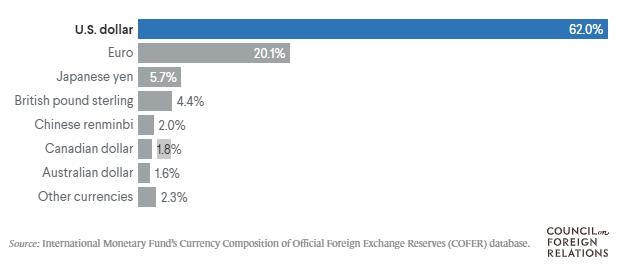
2 minute read
Rise of Cryptocurrencies: A Challenge to Dollar’s Hegemony
by coin gabbar
With a daily trade volume of $2.2 trillion (According to the Bank of International Settlements) and over 62% of all global foreign exchange reserves in 2021, the dollar’s position in the global markets is unbeatable by a significant margin.
However, the rise of cryptocurrencies in 2017 shook the dollar’s monopoly to the core by presenting a decentralized and more efficient alternative to the US dollar.
Advertisement
In 2021, the combined market capitalization of all cryptocurrencies surged past $2 trillion, with Bitcoin alone reaching the historic milestone of a trillion-dollar market cap. Bitcoin was everywhere and global brands such as Tesla, Microsoft, Shopify, and Starbucks started accepting payments in Bitcoins. The rapid pace and magnitude of this transition were so significant that it became nearly impossible for global market watchers to effectively regulate this surging trend.
Blockchain technology and crypto were created with the goal of facilitating faster and cheaper transactions while giving users complete control over their assets. Bitcoin was designed to offer an alternative to traditional, centrally controlled currencies such as the US dollar.
By utilizing a decentralized system of peer-to-peer transactions, cryptocurrencies eliminate the need for intermediaries such as banks, which can lead to faster and cheaper transactions. Additionally, the use of cryptography in cryptocurrency transactions offers increased security and privacy for users.
Bitcoin and other cryptocurrencies are presenting a challenge to the dollar monopoly in international trade by offering universal access to their users and other critical advantages. Bitcoin is a deflationary asset with a limited supply and that gives it a store of value which is not possible with the unlimited supply of US dollars. Bitcoin also does not know any borders and presents a viable option for international trade with increasing adoption every day.




Regional Aspirations and the Role of CBDCs
According to the research report published by IMF in 2022, a ‘stealth erosion’ in the global dollar reserves has been observed over the past decade. This decrease in the dollar reserves does not translate directly into an increase in other prominent currency holdings such as Euro, Swiss Franc, Pound Sterling, or Yen. On the contrary, the study suggests that “the shift out of dollars has been in two directions: a quarter into the Chinese renminbi, and three-quarters into the currencies of smaller countries that have played a more limited role as reserve currencies.”
This study is indicative of the fact that regional currencies that were out of discussions are now willing to create an ecosystem of their own that is completely independent of the US dollar. The rising economies of the world are realizing the drawbacks of dependence on foreign centralized currencies and the stakes associated with it. Emerging global powers such as China, India, Brazil, Russia, and South Africa are looking out for an alternative to the dollar dominance in the market.

Amidst this the rise of cryptocurrencies and now the development of the Central Bank Digital Currencies aka CBDCs has intensified the pace of this ambitious transition.
Here are some of the steps that countries are taking to counter the global dollar dominance:
Countries are collaborating to develop bilateral trade agreements to cut out the role of the US dollar as an intermediary currency
Be it China or India, countries are pushing their native currencies in international trade to promote alternatives to the traditional dollar economy
The last decade has also seen a rise in the power of East-centric financial systems such as the Asian Infrastructure Investment Bank (AIIB), Shanghai Cooperation Organization Development Bank (SCO DB), and others as an alternative to the US-dominated World Bank and IMF
Countries including India are increasing their gold reserves as a hedge against dollar volatility
Countries around the world are developing their CBDCs which will eventually make cross-border transactions much easier and open the gates of interoperable currencies in international trade










